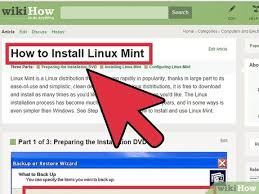4 ways you can start using Linux on windows

4 ways you can start using Linux on windows
There are many reasons why you might want to start using Linux on windows. Perhaps you’re a developer who wants to try out a new operating system, or maybe you’re looking for a more secure and efficient way to work. Whatever your reasons, there are plenty of ways to get started with Linux on windows.
One way to start using Linux on windows is by installing the Ubuntu operating system alongside Windows. This is a great option for those who want to dual-boot their systems, or for those who want to try out Ubuntu without committing to it fully. To do this, you’ll need to create a bootable USB drive or DVD and then follow the instructions for installing Ubuntu alongside Windows.
Another way to start using Linux on windows is by using a virtual machine. This is a great option if you want to run Linux side-by-side with Windows, or if you want to try out multiple Linux distributions without having to install them all on your computer. There are many different virtual machine software options available, so be sure to do some research and find the one that best suits your needs.
If you’re looking for something a bit more permanent, you can always replace Windows completely with Linux. This is obviously a much bigger project than simply installing Linux alongside Windows, but it’s definitely doable. If you’re not sure where to start, there are plenty of resources available online that can help you through the process.
Finally, if you’re just
how to reset the password on windows 7
Assuming you don’t have your password reset disk or installation CD handy, you can reset your Windows 7 password using one of these methods.
Method 1: Use the Hidden Admin Account
Windows 7 has a built-in administrator account that is hidden from the login screen. You can access this account by booting into Safe Mode. Once you’re in Safe Mode, click on the Start menu and type in “Administrator” in the search box. The administrator account will now be visible on the login screen. Enter the administrator credentials and you will be able to reset your password from the User Accounts control panel.
Method 2: Use a Live CD
If you don’t have access to the hidden administrator account, you can use a live CD to reset your password. A live CD is an operating system that can be run from a CD or USB drive without being installed on the computer. There are many live CDs available for download, but we recommend using Ubuntu because it’s free and easy to use.
Once you’ve downloaded the ISO file for Ubuntu, burn it to a blank CD or USB drive using an ISO burning program like ImgBurn or Universal USB Installer. Then boot from the live CD/USB by inserting it into your computer and changing the boot order in the BIOS settings. On the Ubuntu desktop, launch the Terminal application and type in “sudo passwd YOURUSERNAME” (without quotes). This will allow you to change YOURUSERNAME’s
boot to windows

Assuming you have Windows 10 installed, you can use the Windows Subsystem for Linux to run a Linux environment.
1. Enable the Windows Subsystem for Linux feature
First, you need to enable the Windows Subsystem for Linux feature on your machine. You can do this by opening up the PowerShell as Administrator and running the following command:
Enable-WindowsOptionalFeature -Online -FeatureName Microsoft-Windows-Subsystem-Linux
2. Install a Linux distribution from the Microsoft Store
Once the Windows Subsystem for Linux feature is enabled, you can now install a Linux distribution from the Microsoft Store. At the time of writing, there are two distributions available: Ubuntu and OpenSUSE Leap 42.
3. Launch your Linux distribution
Once you have installed a Linux distribution from the Microsoft Store, you can now launch it by clicking on the shortcut that was created on your desktop or in your Start menu. This will launch a console window where you will be prompted to enter your username and password. Once you have entered your credentials, you will be logged into your newly installed Linux distribution.
4. Start using Linux on Windows!
Now that you have a working Linux environment on your machine, you can start using it just like you would use any other operating system. You can install software, create files and directories, and even run shell scripts.
You can use a Linux live CD to reset your Windows password.
A Linux live CD is a bootable disc that allows you to run Linux without installing it on your hard drive. You can use a Linux live CD to reset your Windows password by following these steps:
1. Boot from the Linux live CD.
2. Select “Try Ubuntu” when asked what you would like to do.
3. Enter the command “sudo chntpw -u [username] /media/windows/SAM” where [username] is the name of the user whose password you want to reset. This will open the SAM file, which contains all of the usernames and passwords for your Windows installation.
4. Find the entry for your username and delete the entry entirely (including the username and password). Save and close the file when you’re finished.
5. Reboot into Windows and log in with no password required!
You can use the Windows recovery console to reset your password.
To do this, you’ll need to first boot into the recovery console. To do this, you’ll need to
1. Boot your computer into the Windows Recovery Console. To do this, you’ll need to first boot into the recovery console.
2. Once you’re in the Recovery Console, you’ll be asked to choose which Windows installation you want to access.
3. If you have multiple Windows installations on your computer, select the one that you want to reset the password for and press Enter.
4. At the Command Prompt, type in “net user” followed by the username of the account that you want to reset the password for. Press Enter.
5. Type in “net user [username] *” and press Enter again – this will allow you to enter a new password for that user account.
6. Reboot your computer and try logging in with the new password that you’ve just set!
You can use a third-party utility to reset your password.
If you can’t remember your password, or it’s been a while since you’ve used it, you may be able to reset it using a third-party utility. This process is usually fairly simple and only requires that you have access to the email address associated with your account. Once you’ve reset your password, be sure to choose something strong that you’ll remember so you don’t have to go through this process again.
You can use the built-in administrator account to reset your password.
To use the built-in administrator account to reset your password:
1. Click Start, and then type cmd in the Start Search box.
2. In the search results list, right-click Command Prompt, and then click Run as administrator. If you are prompted for an administrator password or confirmation, type your password or click Continue.
3. Type net user Administrator /active: yes, and then press ENTER. 4. Close the Command Prompt window.
5. Log off Windows, and then log on by using the Administrator account that you enabled in step 3. The default password for this account is blank (no characters).
6 Reset your password by using the following procedure: a) At the Welcome screen, press CTRL+ALT+DEL two times to display the Windows Security dialog box. b) Type your new password in both of those fields, and then click OK twice to close all dialog boxes
windows forgot password
If you’re a Windows user, there’s a good chance you’ve forgotten your password at some point. If you’re using Linux, there’s a way to reset your password if you forget it.
There are a few different ways to reset your password if you forget it. One way is to use a live CD or USB drive. This is a CD or USB drive that has an operating system on it, such as Ubuntu, that you can boot from. Once you boot from the live CD or USB drive, you can reset your password.
Another way to reset your password is to use a recovery disk. A recovery disk is a CD or USB drive that you can create yourself. To create a recovery disk, you’ll need a blank CD or USB drive and the Windows 7 installation disc. Once you have the blank CD or USB drive and the Windows 7 installation disc, follow these instructions:
1. Insert the Windows 7 installation disc into your computer and restart your computer.
2. Choose your language settings and click Next.
3. Click Repair your computer in the bottom-left corner of the window that appears.
4. Click Command Prompt in the list of options that appear.
5. Type these commands into the Command Prompt window:
bootrec /fixmbr
bootrec /fixboot
bootrec /rebuildbcd
6. Press Enter after each command.
7. Type exit and press Enter when
